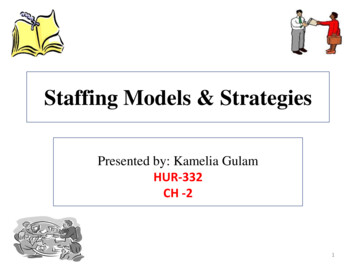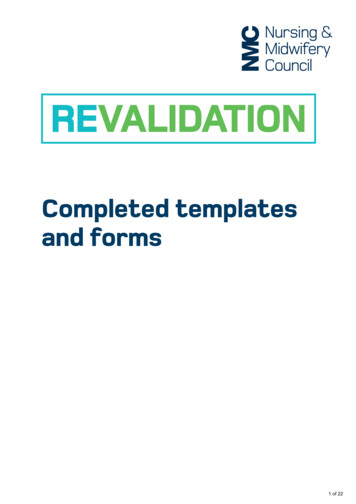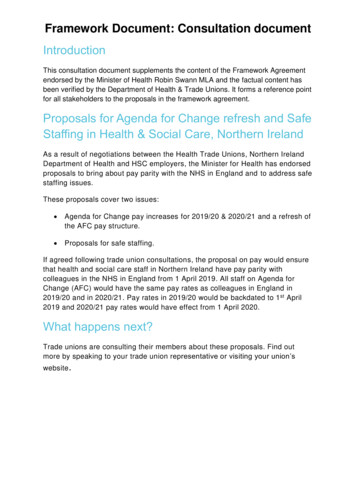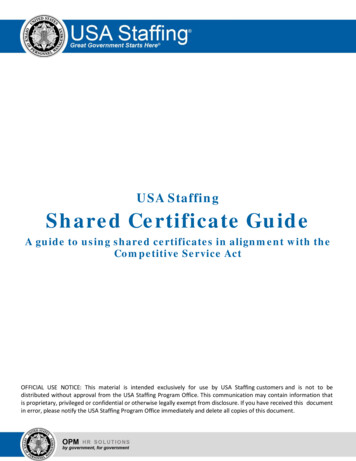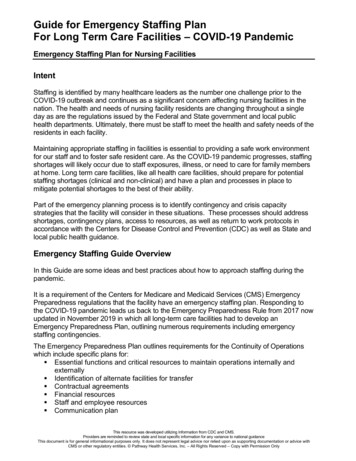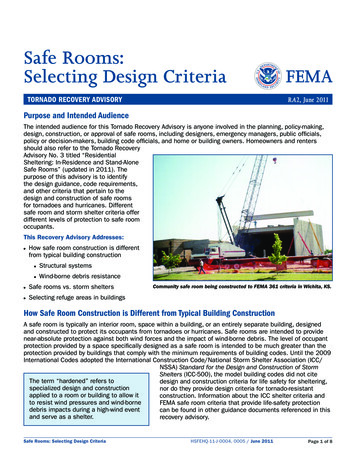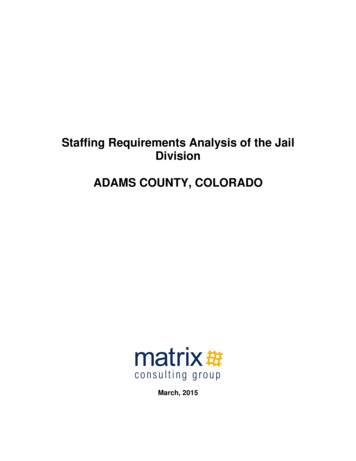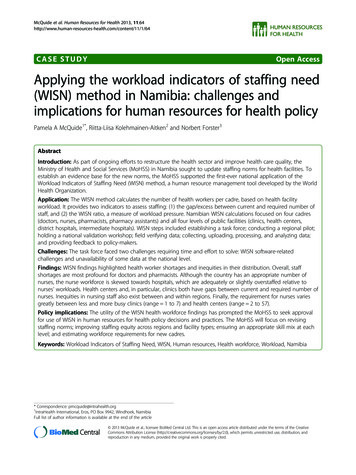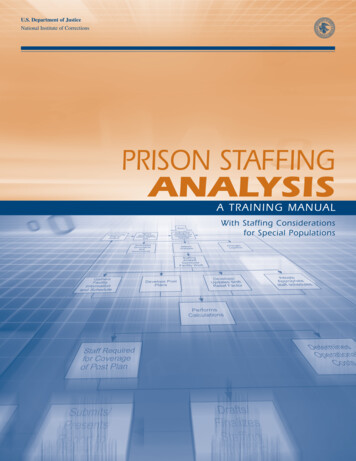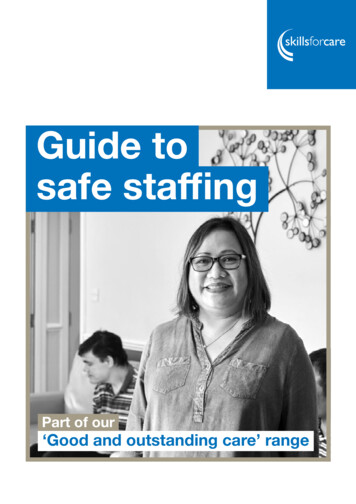
Transcription
Guide to safe staffingGuide tosafe staffingPart of our‘Good and outstanding care’ rangeContents1
Guide to safe staffingHaving enough staff, who have the right values and skills, isfundamental to delivering safe care and support.It’s a major contributing factor to the success of many care providerswho are rated ‘good’ or ‘outstanding’ by the Care Quality Commission(CQC), and a weakness in many services rated ‘requires improvement’ and‘inadequate.’We know that recruitment and retention is a challenge for lots of adultsocial care employers and often directly impacts on their ability to meetand maintain the standards of care that are expected of them.How can this guide help?This guide explains what the CQC looks for in terms of safe staffing andhow you can meet these regulations.It includes guidance around deciding and maintaining safe staffing levelsfor your service, safe recruitment practices and how to ensure your staffare safe and competent.It draws on evidence from over 60 CQC inspection reports and casestudies from residential and community based services who are rated‘good’ and ‘outstanding,’ to help you to understand what ‘good’ looks likeand learn from best practice.Who’s this guide for?This guide’s for anyone involved in CQC inspections in regulated adultsocial care services including directors, board members, registeredmanagers, nominated individuals and compliance managers.If you want to improve safe staffing practice across your service, werecommend that you read the whole guide.If you want to improve safe staffing in relation to a specific key line ofenquiry, go to the ‘What are CQC standards around safe staffing?’ section(on page 8) to see which sections can help.Contents2
Guide to safe staffingSafe staffing is a fundamentalpart of getting care andsupport right for individuals.Across your organisation, it’simportant that you have theright quantity of skilled staff,to meet the needs of yourservice.It’s also essential that thesestaff have the right skills torespond to whatever theyneed to respond to on a dayto day basis.But even when you haverobust processes in place,safe staffing can still presentchallenges for any service.For example staff sicknessor when staff leave withoutworking their notice periods.As a manager you need toknow what to do in thesesituations, and this guide canhelp you do that.Anita Astle, Managing Director, Wren HallNursing Home and Skills for Care Fellow**Skills for Care FellowsFellows are senior leaders who are commited to improving the adult socialcare workforce. They use their expertise to advise us and shape our work.Contents3
Guide to safe staffingContentsClick on each section below to get started. Each section gives you top tips to meet CQCregulations in this area, explains how the CQC inspect this area, and shows what otherproviders do and what to avoid.Introduction1Safe staffing levels – howmany staff do you need?2Safe recruitment practices –recruit the right staff to deliversafe care and support3Safe and competent staff –ensure staff are competent todeliver safe care and support What is safe staffing? What are the warning signs of inadequatestaffing? What are CQC standards around safestaffing? Other resources to help Decide how many staff you needPlan your staffing rotaPut contingencies in placeReview your staffing levelsUsing technology to support safe staffing Plan your recruitment Attract and select the right people Review your recruitment and retentionactivities Give new staff a thorough induction Provide learning and developmentopportunities for staff Support your staffContents4
Guide to safe staffingIntroductionThere are always enough competent staff on duty. Staff have the rightmix of skills to make sure that practice is safe and they can respondto unforeseen events. The service regularly reviews staffing levels andadapts them to people’s changing needs.CQC “good” ratings characteristics– adult social care servicesWhat is safe staffing?Safe staffing is about having enough staff, who have theright values and skills, to deliver high quality care andsupport. It involves: having safe staffing levels, including puttingcontingency plans in place recruiting the right people, with the right values, skillsand experience to deliver safe care and support doing the right recruitment checks ensuring staff are competent and safe to do theirrole.Safe staffinglevels aren’t justabout numbers– they’re aboutskilled andexperienced staffoperating withinclear, agreedand ethical careplans. They’realso about havinga low turnover sothat staff actuallystay long enoughto form effectiverelationships withresidents.Getting this right means far more than achieving a goodinspection rating, it means that people receive safe andeffective care and support that’s responsive to their needs.If you get it wrong, you could put your staff and the peopleyou support at risk. For example, staff shortages putservices under extreme pressure and can mean staff haveto choose what care can or can’t be delivered that day.This could lead to neglect and/or a safeguarding incident,a damning inspection and reputational damage.It can also impact your existing workforce. For exampleif you have good staff who routinely work through theirbreaks or have a poor work-life balance due to workingextra shifts, it can lead to mental ill-health and decreasedmotivation in your service.Jason Denny,Registered Home Manager,Old Hastings HouseContents5
Guide to safe staffingIf you don’t have enough staff you may put too much pressure on theexisting workforce - asking them to cover more than they can, cancause people to burn out.My organisation manages over 600,000 domiciliary visits a year so it’simportant we have trust in our processes and systems.As chief executive, I know every week how many hours of care we needto deliver and how many staff we’ve got to do this.We have a process of capacity planning so that I know how muchflexibility we have with staffing levels each week. This helps me toidentify challenging periods, such as school holidays, and ensures thatwe can respond to them.Melanie Weatherley, Chief Executive, Walnut Care and Skills for Care FellowContents6
Guide to safe staffingWhat are the warning signs ofinadequate staffing?There are some common characteristics of serviceswho have inadequate staffing. If some, or all, of theseapply to your service this could indicate that you’re notmeeting the requirements for safe staffing. High turnover of staffStruggle to recruit enough staffNew staff leave within a short time of joiningHigh sickness rates that are particularly stressrelatedUnorganised rota system and processes that aredifficult to use and reviewRotas are constantly changingStaff only have time to perform duties and taskswith no time to ‘care’Staff don’t have time to communicate withpeople they support, families and professionalsLittle consistency in staffOver-reliance on temporary workersStaff inductions are limited and/or rushedStaff learning and development is restricted tomandatory trainingLimited support for staff such as supervisionsThe impact on residential services mightinclude: no time to respond to calls for help not enough time to do an effectivehandover staff support people to get ready andhave meals at a time that best suits themrather than the individual not enough staff to support people atmeal times medication documentation is rushed.Too manyproviders werestruggling along withouthaving enough staff todeliver safe and effectiveservices. It wasn’tgenerally because thestaff didn’t care; it wasbecause they didn’t havethe time to care as wellas they should.CQC planning improvement inadult social care (2018)The impact on community services mightinclude: staff miss or are late for appointments staff are unable to report their concernsto the managers customers are unable to get in contactwith the office.You can use this guide to improve your practice.Contents7
Guide to safe staffingWhat are CQC standards aroundsafe staffing?The CQC regulations explain the minimum standards that adult social care services need tomeet regarding safe staffing.Regulation 18 states:1. Sufficient numbers of suitably qualified, competent, skilled and experienced personsmust be deployed in order to meet the requirements of this part.2. Persons employed by the service provider in the provision of a regulated activity must:a. receive such appropriate support, training, professional development, supervisionand appraisal as is necessary to enable them to carry out the duties they areemployed to performb. be enabled where appropriate to obtain further qualifications appropriate to thework they performc. where such persons are health care professionals, social workers or otherprofessionals registered with a health care or social care regulator, be enabled toprovide evidence to the regulator in question demonstrating, where it is possible todo so, that they continue to meet the professional standards which are a conditionof their ability to practise or a requirement of their role.Elements of safe staffing are also included in: Regulation 9: Person-centred care Regulation 12: Safe care and treatment Regulation 13: Safeguarding service users from abuse and improper treatment Regulation 15: Premises and equipment Regulation 19: Fit and proper persons employed.You can read more about these regulations on the CQC website at www.cqc.org.uk. Theyhave guidance and FAQs to help.These regulations are inspected across multiple key lines of enquiries (KLOE’s).Because staffing has an impact on more than just the ‘safe’ area of inspection, it’s inspectedacross multiple key lines of enquiry (KLOE) – in other words, the KLOEs are often only possibleto achieve if the service is safely staffed.Contents8
Guide to safe staffingHere are the main KLOE’s that the CQC will look at in inspection around safe staffing. We’veincluded a link to where you can find more information in this guide.SafeWhat will the CQC look at as part of theirinspection?Where can I find moreinformation in this guide?S2.3 Are people’s records accurate, complete, legible,up-to-date, securely stored and available to relevantstaff so that they support people to stay safe?Safe recruitment practicesS3.1 What arrangements are there, including withinthe rotas, for making sure that staff have the right mixof skills, competencies, qualifications, experience andknowledge, to meet people’s individual needs?Safe staffing levelsSafe recruitment practicesSafe and competent staffS3.2 How is safety promoted in recruitment practices,arrangements to support staff, training arrangements,disciplinary procedures, and ongoing checks?Safe recruitment practicesSafe and competent staffS3.3 Do staff receive effective training in safetysystems, processes and practices?Safe and competent staffEffectiveWhat will the CQC look at as part of theirinspection?Where can I find moreinformation in this guide?E2.1 Do people have their assessed needs, preferencesand choices met by staff with the right qualifications,skills, knowledge and experience?Safe and competent staffE2.2 Are staff supported to keep their professionalpractice and knowledge updated in line with bestpractice?Safe and competent staffE2.3 Do staff and any volunteers have effective andregular mentorship, support, induction, supervision,appraisal and training?Safe and competent staffE3.3 Are meals appropriately spaced and flexible tomeet people’s needs, and do people enjoy mealtimesand not feel rushed?Safe staffing levelsContents9
Guide to safe staffingCaringWhat will the CQC look at as part of theirinspection?Where can I find moreinformation in this guide?C1.4 Do staff know and respect the people they arecaring for and supporting, including their preferences,personal histories, backgrounds and potential?Safe recruitment practicesC2.3 Does the service give staff the time, training andsupport they need to provide care and support in acompassionate and personal way? Are rotas, schedulesand practical arrangements organised so that staff havetime to listen to people, answer their questions, provideinformation, and involve people in decisions?Safe staffing levelsResponsiveWhat will the CQC look at as part of theirinspection?Where can I find moreinformation in this guide?R1.6 How is technology used to support people toreceive timely care and support? Is the technology(including telephone systems, call systems and online/digital services) easy to use?Safe staffing levelsWell-ledWhat will the CQC look at as part of theirinspection?Where can I find moreinformation in this guide?W2.1 Do staff receive feedback from managers in aconstructive and motivating way, which enables themto know what action they need to take?Safe and competent staffW3.1 How are staff actively involved in developing theservice? Are they encouraged to be involved inconsidering and proposing new ways of working,including ways of putting values into practice?Safe staffing levelsSafe recruitment practicesW4.5 How does the service measure and review thedelivery of care, treatment and support against currentguidance?Safe staffing levelsSafe recruitment practicesContents10
Guide to safe staffingOther resources to helpWe have other resources to help you prepare for inspection and improve your service.Making your inspection count seminarIf you’re involved in CQC inspections in your service,our ‘Making your inspection count seminar’ will help youunderstand, prepare for and implement the changes to CQCinspections that were introduced over the past year.You’ll learn about the changes to CQC inspections, whatinspectors are looking for and how you can evidence this.You’ll also access an evidence and action planning tool tohelp you put your learning into practice and prepare for yournext inspection, and have the chance to network with peersand discuss your service’s specific challenges and issues.Find out more atwww.skillsforcare.org.uk/CQCseminars.Good and outstanding care guideOur ‘Good and outstanding care guide’ draws on tips and practicalexamples from providers already rated good and outstanding.It shows what differentiates CQC ratings and shares recommendationsand best practice under each area of inspection.Good anoutstan dding caguide updateredWorkbook editionIf you’re already rated good or outstanding, it’ll help you maintain orimprove your rating. If your service requires improvement, it’ll help youavoid some of the common mistakes and take a proactive approach toimproving standards.Download your copy of the guide at www.skillsforcare.org.uk/GO.You can also purchase the workbook edition which has activities and self-assessmentchecklists to assess your current performance and identify areas for improvement.Contents11
Guide to safe staffing1. Safe staffing levelsIt’s your responsibility to decide how manystaff you need to deliver a safe, effectiveand responsive service and ensure you planyour staffing to maintain this.There’s no one solution to doing this – it’ll depend onyour service and the people you support, and it mightchange over time.This section will help you to decide how many staff youneed, plan your staffing rota and put contingencies inplace to maintain safe staffing levels.Providers should have asystematic approach todetermine the numberof staff and range ofskills required in orderto meet the needs ofpeople using the serviceand keep them safe at alltimes. The approach theyuse must reflect currentlegislation and guidancewhere it is available.CQC Regulation 18 GuidanceGet startedClick on each section to get started.1.1 Decide how many staff you need1.2. Plan your staffing rota1.3. Put contingency plans in place to maintain safe staffing levels1.4. Review your staffing levelsUsing technology to support safe staffingHow will the CQC inspect this?What other providers doWhat to avoidContents12
Guide to safe staffing1.1 Decide how many staff you needYou need to use an effective system, such as a dependency tool, andprocess to decide how many staff you need.It should consider the needs and wishes of the people you support, alongside other factorssuch as time for additional activities, reporting, training and travel time.Top tips: things to considerDecide staffing levels depending on the needs and wishes of the people yousupport. Use realistic formulas when you do this that go beyond ‘care tasks’ toinclude their needs and wishes (for example activity provision or access to thecommunity).Ensure staff are given enough time to do everything that’s involved in their roleoutside of directly delivering care, for example filling in documents, handovers,engaging with healthcare professionals, talking to relatives, checking cleanliness,supervisions and their own personal development.Consider environmental issues that might impact on staffing levels, for examplethe layout of the care home or location of people who access homecare.Consider factors above and beyond work-time regulations that can impact yourstaff’s ability to deliver safe care and support, for example long shifts may causefatigue.Think about times when you might need more staff and be prepared to change therota, for example during busy times of day, when someone’s needs increase orwhen someone’s receiving end of life care.If you regularly use new or inexperienced care workers, bank workers, volunteersand recruitment agency workers, consider the impact this has on moreexperienced workers’ productivity. Consider whether your current approach tostaffing in this way is realistic and sustainable.Be realistic about the impact of staff turnover, annual and special leave, sickness,supervisions and learning and development will have on your staffing levels.Include time for these and base levels on real recent data rather than overlyoptimistic targets.Ensure that staff who determine staffing levels are competent to do so. Theyshould be familiar with CQC regulations, relevant legislation and standards, havethe right skills such as number and problem solving skills, and be trained in anysystems you use.Chapter menu13Contents
Guide to safe staffingMore information: Dependency toolsDependency tools can help you to decide how manystaff you need. You can use them to collate informationabout the needs (or dependency) of people who needcare and support, how many hours/staff support youneed, and log other requirements such as time foradministration, record keeping and communicating.This can help you make informed decisions about howmany staff you need in your service to meet safestaffing levels.Supporting people withall their needs, such asspending one to one timewith people, socialising,going out and attendingappointments wasincorporated into thedependency tool usedto calculate and reviewstaffing levels.It also provides evidence for your inspection about howand why you’ve decided these levels. One CQCinspection report from a residential home ratedCQC inspector, residential care‘requires improvement’ for ‘safe’ said:home rated ‘outstanding’ for“The registered manager told us they didn’t use a‘safe’formal dependency tool but assessed the staffinglevels through observation and how care tasks werecompleted by staff. A lack of a formal dependency tool did not assess if staffing levelsremained sufficient if people’s needs changed or numbers of people living at the serviceincreased. It also did not take into account the geography of the building when the bedroomson the first floor were in use.”When you use a dependency tool, ensure staff are competent to use it and use it consistently.If they don’t, this can have a negative impact on the outcome of your inspection. One CQCinspection report from a residential home rated ‘inadequate’ said:“The provider used a safe staffing assessment tool to calculate the number of staff neededfor each shift. We checked the records of the assessment tool and found this hadn’t beencompleted for some weeks and the provider was unable to demonstrate on what basis they’ddecided the current staffing numbers per shift against the needs of people.”There are lots of tools on the market or you could invest in a bespoke tool to meet yourservice’s needs. We don’t recommend a particular dependency tool but you can find out more: onlineat local and national eventsdependency tool providers might contact you directlyby speaking to other social care providers about what tools they use and recommend.Chapter menu14Contents
Guide to safe staffingWhat works for us:Voyage CareVoyage Care use a care funding calculator to determine their staffing levelsand ensure this includes time for staff to build relationships with the peoplethey support. They told us:“Each person we support is allocated care hours when they arrive in the serviceto ensure their needs are being met. Our care manager does an assessment tocalculate this time as part of the transition period, and we regularly review this.We use a care funding calculator to determine how many hours of care is neededon a 1:1 basis, throughout the day and night, and why these hours are needed.When we schedule our rotas, we also build in enough time for staff to buildrelationships with people.This ensures that our staffing levels meet the needs of the people we support andare safe for 24 hours a day. Our care manager does regular reviews to ensure thatthis continues.We also hold monthly ‘keyworker’ meetings with individuals and team meetingswhere we can discuss staffing levels and identify areas for improvement.”Darren Crowton, Registered ManagerChapter menu15Contents
Guide to safe staffing1.2 Plan your staffing rotaOnce you know how many staff you need, for example from a dependency tool,you need to use this data to plan your staffing.If your staffing levels don’t match the data from the dependency tool, you could put peoplewho need care and support at risk. One CQC inspection from a residential care home rated‘inadequate’ for ‘safe’ said:“We were told six people required two staff to assist with their care needs. This meant betweenthe hours of 8am and 10am and 6pm and 8pm, if a person was being assisted by two carestaff, there were no care staff to provide assistance to other people.”A good rota system, which lists your staff and other information such as location, workingtimes and their responsibilities, will help you do this.When you plan your staffing you also need to think about continuity of care – this meanshaving consistent staff and matching them with people who need care and support. Thisenables staff to build relationships with the people they support, develop person-specific skillsand knowledge, and means they’re more likely to notice changes in health and wellbeing – allof this supports safe staffing. It also means a better experience for people who need care andsupport.The number of staff on duty changed to reflect thenumber of people using the service each day.The registered manager worked five days a week anda minimum of a senior, three support workers, a healthand nutrition worker and housekeeper were on dutyeach day.Overnight there was a waking night shift worker and oneto two sleep-in staff.CQC inspector, residential care home rated ‘good’ for ‘safe’Chapter menu16Contents
Guide to safe staffingTop tips: things to considerUse data from a dependency tool (or other process) to plan your staffing.Communicate staffing with your workforce and give them appropriate notice, forexample through a staff rota.Have a system in place to alert concerns with staffing levels so you can promptlyrespond, for example automated alarms, electronic notifications and escalatingconcerns to managers.Ensure that staff who are responsible for determining safe staffing levels areavailable as an escalation point and know what to do in case of emergency.Have contingencies in place for short term staff shortages such as if someone isill or doesn’t turn up for work, and ensure that responsible staff know what theseare.If there are any incidents relating to safe staffing, investigate them and use whatyou learn to improve your practice.Chapter menu17Contents
Guide to safe staffingMore information: Using rotasA good rota will help you plan your staff schedule, communicate it with staff and people whoneed care and support, and provide evidence for your CQC inspection.When you use a rota system you need to:Be clear about who’s involved in arranging the rota and ensure they know theirresponsibilities and are competent to do them. This could be a registered manager,HR or administration worker. They need to understand your business and have good IT,problem solving and number skills.If you use an electronic rota system, ensure it’s simple to use and that all staffunderstand how to use it – this might include regular training.Implement ‘version control’ to your rota to reduce any confusion when the rotachanges, and ensure staff know where the most up to date rota is.Share your rota as early as possible, in a consistent way, so people who need careand support and staff can plan their lives. Give staff easy ways to access the rota forexample online, in paper or on mobile devices.Tell people if the rota changes and explain why you’ve done this. If you use anelectronic system you might be able to send out automatic notifications and alerts.Review your rota regularly and include staff in this review. Listen to and act on theirfeedback to make improvements.We plan a permanent pattern of work sostaff know their rota six weeks in advance,and we try to let them know who they’llbe visiting two weeks before. This workpattern means staff know when they’llbe working for the year ahead whichsupports their work-life balance. It alsomeans we expect staff to plan all nonemergency appointments on their day off.We give staff paper copies of the rota tostaff and share it on the app.Chapter menu18Contents
Guide to safe staffingWhat works for us:Walnut CareWalnut Care start by planning their visits with Lego and use an online systemto automate their rota and communicate with staff. They told us:“When we’re planning our staffing levels, we start by using Lego!I come from an accountancy background and we used Lego to plan who wasdoing which audits and when. We found that this same principle can be applied tomanaging a care service.We split care visits up by the travel routes that our staff take, and write on a post itnote the different visits we need to do on that route.We then build this in Lego.Each Lego brick represents a five minute block of care time and we use differentcoloured bricks to represent the different villages we operate in. We then allocatestaff to each block of Lego and identify if there are any gaps.We can then easily transfer this information into our computer system whichautomates our staff rota.We’ve found that having a visual representation really helps us to plan our staffing.For example during times when we’re at risk of staff shortages, such as schoolholidays, it’s quick and easy for me to manage staff holiday requests and find coverfor shifts.The Lego sits on the wall in our office so staff can easily shuffle visits around ifpeople ask us to fit in extra visits or we get new clients. This means that we don’twaste time and resources re-planning visits every week.”Melanie Weatherley, Chief ExecutiveChapter menu19Contents
Guide to safe staffingMore information: Continuity of carePeople who use services are best served by having a stable group ofstaff they know and who know them.Driving improvement in adult social care, CQCWhen you plan your staffing, it should support continuity of care.This enables staff to build relationships with the people they support, get to know them andtheir needs better and develop their skills and knowledge around the person. They’re also morelikely to notice changes in people’s health and wellbeing.You need to ensure that your staffing and operational management enables continuity of care.Here are some things you need to consider.Match people who need care and support with appropriate staff. You could dothis based on: their skills and knowledge their personality and interests.You could ask staff and people to write a personal profile to support the matchingprocess.Review the matching regularly and act promptly if it isn’t working.Ensure people who need care and support have a small and specific care team whoknow their needs and wishes. Where possible, use the same people to provide careand support.If a new or temporary worker is providing care and support, ensure they have timeto read the person’s care plan and introduce themselves before they start.Allow enough time for staff to do a safe and effective handover between different shiftsor staff. This could be done in person, handwritten notes, electronic records orover the phone. Document these and share them with staff.If someone raises an important issue in a handover, update other documents whererelevant. For example you might need to revise someone’s care plan or do a riskassessment.Chapter menu20Contents
Guide to safe staffingWhat works for us:Care ConcernCare Concern is a homecare provider who match their clients with a smallgroup of regular staff. They told us:“We introduce a small team of carers to each client so they receive consistent careand support from people who know them. It’s so important that carers and clientsbuild a relationship based on trust, and regular visits from the same carers helps.We have a dedicated coordinator who does our rotas each week. Our softwareremembers which carers have visited which clients and prompts us to make thatmatch where possible. We can also put staff on a ‘declined list’ if someone requeststhis.”Bernadette Kendall, Registered ManagerChapter menu21Contents
Guide to safe staffingMore information: Doing a safe handoverA good handover ensures staff have the rightinformation about the people they’re supporting so theycan provide
4 Guide to safe staffing Contents Contents Click on each section below to get started. Each section gives you top tips to meet CQC regulations in this area, explains how the CQC inspect this area, and shows what other
